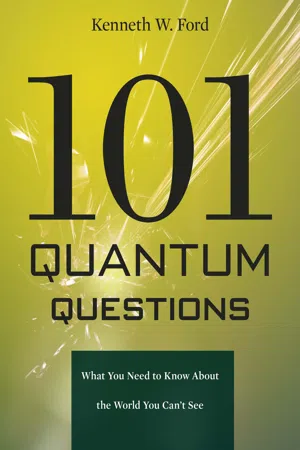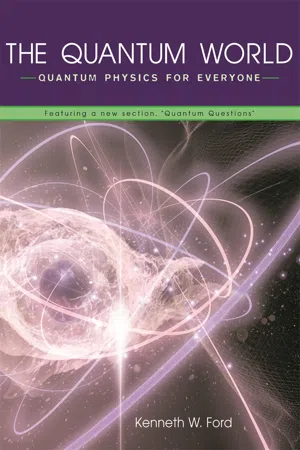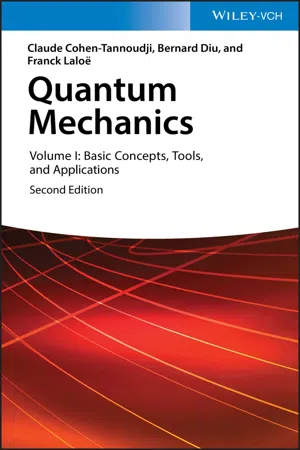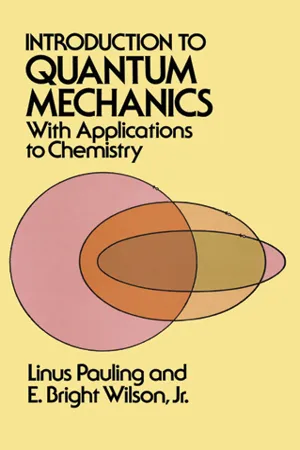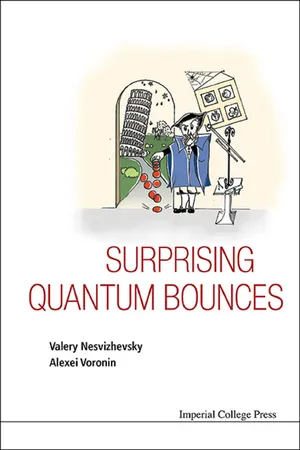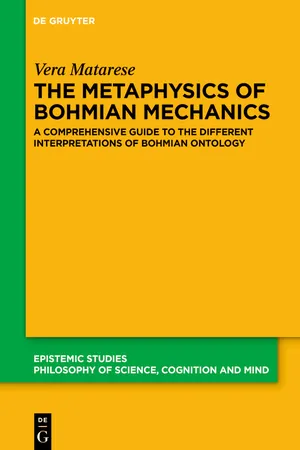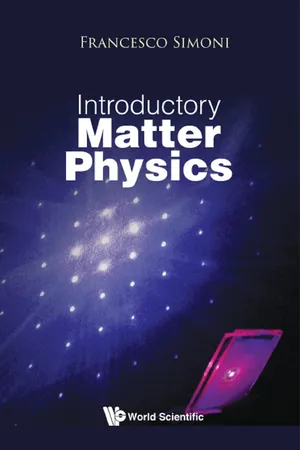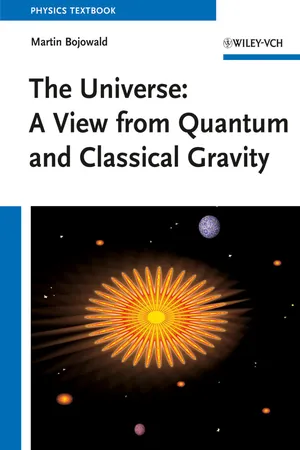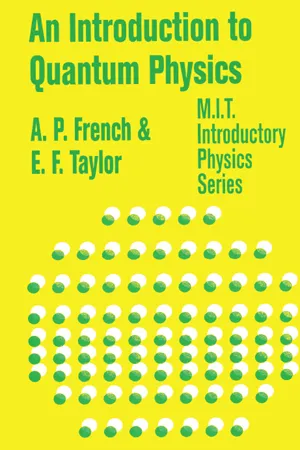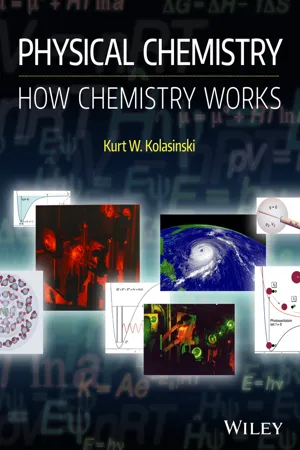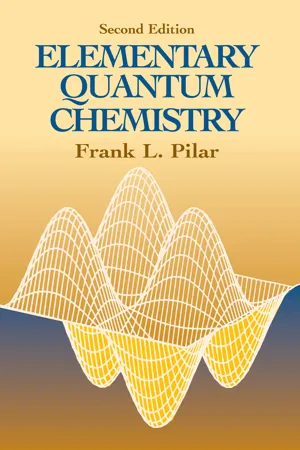Physics
Wave Function
The wave function in physics is a mathematical description of the quantum state of a system. It represents the probability amplitude of finding a particle in a particular state. The wave function is a fundamental concept in quantum mechanics and is used to calculate the behavior and properties of particles at the quantum level.
Written by Perlego with AI-assistance
Related key terms
Related key terms
1 of 4
Related key terms
1 of 3
11 Key excerpts on "Wave Function"
- eBook - ePub
- Kenneth W. Ford, Paul Hewitt(Authors)
- 2011(Publication Date)
- Harvard University Press(Publisher)
section XII Waves and Probability71. What is a Wave Function? What is Schrödinger’s equation?I have referred earlier to the role of probability in quantum physics—for instance, that an electron has a certain chance to be found at various places within an atom, or that a photon passing through a double slit has a certain chance to land at various spots. Something called the Wave Function controls this probability. A Wave Function gives an amplitude, a measure of how strongly a wave deviates from a zero value, either positively or negatively. This is analogous to how much water surface deviates, upward or downward, away from its normal level as a wave passes by. But there is one big difference between the quantum wave and the water wave. The quantum wave is not itself a measurable quantity. The quantity that can be measured is probability, and that is the square of the quantum wave amplitude. Moreover, the quantum wave amplitude can be what is called a complex number, meaning that it has real and imaginary parts. The probability is then given by what is called the absolute square of the amplitude, which is indeed a real number and a measurable quantity. In the discussion that follows, I will not pursue this technical detail. Suffice it to say that the squared amplitude gives the probability.Probability implies uncertainty, a lack of sure knowledge. Indeed uncertainty, or “fuzziness,” is a hallmark of quantum physics. Yet there is definiteness involved here, too. The Wave Function of an electron in a particular state of motion in a hydrogen atom has a perfectly well-defined value at every point. Its square, the probability, is also perfectly definite. And this definiteness extends from one atom to another. If a thousand hydrogen atoms are all in the same state of motion, they all have identical Wave Functions and identical distributions of probability. What is not definite is advance knowledge of where the electron might be found as a particle if an experiment is conducted to pinpoint its location. Identical experiments carried out on the thousand atoms might reveal the electron’s location at a thousand different points. It’s a bit like throwing a pair of dice. You know exactly (if it’s a fair and balanced pair) the probability of throwing any given sum (1 ⁄6 for a sum of seven, 1 ⁄36 - eBook - ePub
The Quantum World
Quantum Physics for Everyone
- Kenneth W. Ford(Author)
- 2005(Publication Date)
- Harvard University Press(Publisher)
choice among results of an event, and so on.As I mentioned in Chapter 6 , Einstein was unhappy about the appearance of probability in fundamental physics, and often said he could not believe that God played dice. Nearly all physicists have made peace with probability, but some remain uneasy about it. I very much doubt that the last word on quantum physics has been spoken.Waves and Granularity
Far from the center of an atom, the Wave Function of one of the atom’s electrons is very close to zero. The Wave Function may rise to a single maximum at the atom’s center, then fall again to near zero on the other side of the atom. Such is the Wave Function’s behavior for the lowest-energy state (the ground state) of the hydrogen atom, depicted in Figure 38 . For more energetic states (excited states), the Wave Function undergoes two or more cycles of oscillation: either in and out, toward and away from the atom’s center, as shown in Figure 39 , or round about, circumferentially around the nucleus.Figure 39. Electron Wave Function in higher-energy state of a hydrogen atom.This behavior is reminiscent of the vibration of a violin string in its fundamental mode and in its higher harmonics. The lowest vibration frequency of a string held fixed at its two ends has one-half wavelength over the length of the string. The second harmonic is one in which there is a full wavelength over the length of the string. The third harmonic has one-and-a-half wavelengths from end to end. And so on. It is in the nature of the rules governing sound that the frequency of the second harmonic is twice the frequency of the fundamental (up one octave, in musical terminology), the frequency of the third harmonic is three times the frequency of the fundamental, and so on. When a violin string is bowed, all of these overtones, as they are called, sound together. The particular quality of the sound depends on the relative intensities of the overtones. But what is important for this discussion is that the frequencies of vibration of the violin string are quantized. A string of given length and tension vibrates only at a discrete set of frequencies. - eBook - ePub
Quantum Mechanics, Volume 1
Basic Concepts, Tools, and Applications
- Claude Cohen-Tannoudji, Bernard Diu, Franck Laloë(Authors)
- 2020(Publication Date)
- Wiley-VCH(Publisher)
Moreover, the predictions of the measurement results are now only probabilistic (they yield only the probability of obtaining a given result in the measurement of a dynamical variable). The Wave Function is a solution of the Schrödinger equation, which enables us to calculate ψ (r, t) from ψ (r, 0). This equation implies a principle of superposition which leads to wave effects. This upheaval in our conception of mechanics was imposed by experiment. The structure and behavior of matter on an atomic level are incomprehensible in the framework of classical mechanics. The theory has thereby lost some of its simplicity, but it has gained a great deal of unity, since matter and radiation are described in terms of the same general scheme (wave-particle duality). We stress the fact that this general scheme, although it runs counter to our ideas and habits drawn from the study of the macroscopic domain, is perfectly consistent. No one has ever succeeded in imagining an experiment that could violate the uncertainty principle (cf. Complement D I of this chapter). In general, no observation has, to date, contradicted the fundamental principles of quantum mechanics. Nevertheless, at present, there is no global theory including quantum phenomena within general relativity (gravity) and, of course, nothing prevents the possibility of a new upheaval. References and suggestions for further reading: Description of physical phenomena which demonstrate the necessity of introducing quantum mechanical concepts: see the subsection “Introductory work – quantum physics” of section 1 of the bibliography; in particular, Wichmann (1.1) and Feynman III (1.2), Chaps - Linus Pauling, E. Bright Wilson, E. Bright Wilson(Authors)
- 2012(Publication Date)
- Dover Publications(Publisher)
The problem of the normalization of Wave Functions of this type, the value of which remains appreciable over an infinite volume of configuration space (corresponding to a continuous spectrum of energy values), is a complicated one. Inasmuch as we shall concentrate our attention on problems of atomic and molecular structure, with little mention of collision problems and other problems involving free particles, we shall not discuss the question further, contenting ourselves with reference to treatments in other books. 1 In discussing the physical interpretation of the Wave Functions for this system, let us first consider that the physical situation is represented by a Wave Function as given in Equation 13–11 with W y and W z equal to zero and W x equal to W. The function 1 is then a set of standing waves with wave fronts normal to the x axis. The wave length is seen to be given by the equation In classical mechanics the speed v of a free particle of mass m moving with total energy W is given by the equation 1/2 mv 2 = W. A further discussion of this system shows that a similar interpretation of W holds in the quantum mechanics. Introducing v in place of W in Equation 13–12, we obtain This is the de Broglie expression 2 for the wave length associated with a particle of mass m moving with speed v. It is the sinusoidal nature of the Wave Functions for the free particle and the similar nature of the Wave Functions for other systems which has caused the name wave mechanics to be applied to the theory of mechanics which forms the subject of this book. This sinusoidal character of Wave Functions gives rise to experimental phenomena which are closely similar to those associated in macroscopic fields with wave motions- eBook - ePub
- Valery Nesvizhevsky, Alexei Voronin(Authors)
- 2015(Publication Date)
- ICP(Publisher)
wave . We are going to use this momentum–space relation further on.The practical advice of quantum mechanics for any concrete problem is to solve a wave-equation in order to find a wave-function, then to predict the probability of measuring any physical value of the particle using this wave-function.The famous Schrödinger equation 2 , the quantum equation of motion, allows us to calculate a wave-function in any point of space at any moment of time, and thus it provides us with the full description of a quantum system.In order to get a feeling how such an equation could be discovered in a more general case, try to derive it yourself by means of solving Problem 2.2 .Problem 2.2. Guess what the form of equation is for the wave-function of a freely moving particle .Note: Take into account that the solution of this equation is given in the expression (2.3).Again, we write down the solution for this problem immediately as we need it to have known explicitly in order to continue:Note: Take also into account that the equation, which has to be found, should not change while being written in a rotated frame of reference as it should follow from the invariance of physical laws under the operation of rotation.Using this very brief outline of principal statements of quantum mechanics, we underline that the wave character of motion of a quantum particle imposes that the particle has to be associated with a wave-function, which (generally speaking) should be defined in every point of space at any moment of time. Such a wave-function provides a complete self-consistent description of quantum motion.In order to understand what is in fact motion in quantum case, as well as to analyze what physical characteristics of quantum motion could be measured, let us think of another “imaginary Pisa tower” experiment, but now with a falling object in the form of a quantum particle. At the moment we do not care what kind of physical particle it is, although below we are going to discuss its eventual nature in detail, with references to real realizations and experiments. - eBook - ePub
The Metaphysics of Bohmian Mechanics
A Comprehensive Guide to the Different Interpretations of Bohmian Ontology
- Vera Matarese(Author)
- 2023(Publication Date)
- De Gruyter(Publisher)
In their paper The wave-function as a multi-field, Hubert and Romano (2018) interpret the wave-function as a multi-field which for a system of N particles specifies a precise value for the entire N-tuple of points in three-dimensional space, thus determining, given the actual positions of N particles, the motion of all particles. In this regard, the resulting ontology is all in our three-dimensional space: the wave-function decorates our 3D physical field and not the 3ND configuration space, as it assigns intrinsic properties (represented by complex values) to particular N-tuples of points of three-dimensional space and not to single points of the configuration space. An alternative, proposed by Romano, is also to take the two fields composing the wave-function, the R-field and S-field as multi-fields. These are real-valued scalar functions expressing the amplitude and the phase of the wave-function, which assign real values to each N-tuple of points representing the actual location of the Bohmian particles, in the three-dimensional space. The multi-field view has also been defended by Chen (2017), who proposes to regard the quantum wave-function as assigning properties to each plurality of point in our three-dimensional space, exactly in the same way we regard the electromagnetic field as assigning properties to each point in our three-dimensional space. Chen further stresses that the multi-field defined over N-pluralities of points in a three-dimensional space is equivalent to the quantum wave-function defined over each point in the configuration space. This view has the great merit of avoiding the most difficult challenge of wave-function realism, which is that it features a fundamental ontology in a 3ND space. However, several other challenges remain in place. The first one concerns the absence of back-action from the particles to the field - eBook - ePub
- Francesco Simoni(Author)
- 2018(Publication Date)
- WSPC(Publisher)
For this reason, we find the physical meaning of | A (x, t)| 2 as being proportional to the probability of finding the electron in the position x at time t. This statistical approach is the most radical change with respect to the classical deterministic point of view. In Newton’s mechanics, the second law of dynamics describes the dynamic conditions of a particle and, together with the initial conditions of motion, it allows determining all the characteristic physical quantities. On the contrary, the quantum point of view means identifying the Wave Function that describes the motion of a particle under specific dynamical conditions, which include the boundary conditions, and getting from it the expected physical quantities as most probable among a number of possible values. In order to follow this logic, one needs a starting equation that all the Wave Functions must obey, playing a role that in classical mechanics is played by Newton’s equation F = m a. This role is played by the Schrödinger equation which must be integrated to find the Wave Function describing the particle in any specific physical condition. From it one should be able to find the probability distribution of the particle position and of the other relevant dynamical quantities. 2.3. The Schrödinger equation To get Wave Functions describing many different physical situations requires a basic equation valid in any case, in order to solve the general problem as integration of such an equation. In fact, a simple wave packet created by superposition of plane waves makes understandable how a wave description can be adopted for a particle, but it is not suitable for treating most of the cases, mainly because of dispersion, i.e - eBook - ePub
The Universe
A View from Classical and Quantum Gravity
- Martin Bojowald(Author)
- 2012(Publication Date)
- Wiley-VCH(Publisher)
n = 10. The Wave Function varies much within the well, but provides an almost constant probability for position measurements with low position resolution. For such measurements, the likelihood of finding the particle is uniform within the well.The set of energies is discrete, but not equally spaced. Differences of neighboring energy levels increase as (n + 1)2 − n2 = 2n + 1 as n grows. Photons with frequencies f = (En+1− En)/h = h (2n + 1)/(8m a2 ), proportional to an odd integer, can be emitted or absorbed.The frequencies, not just the energies of photons, are proportional to h. If h is much smaller than other quantities, as in many classical systems, photons of almost any frequency can be emitted or absorbed. There is no resonance phenomenon as with the harmonic oscillator. A classical particle in the trap would move freely, undisturbed by any force, until it reaches the walls. Instantly reflected back, it then continues its motion with the same velocity, just in the opposite direction. It bounces back and forth, retaining the value of its kinetic energy. If it is hit by a photon, it can absorb all the energy and move faster. There is no influence by a force that would make it react selectively to varying photon frequencies.Free particle Nothing in physics is bound forever. We would need infinite forces or infinite jumps in potentials to keep an object confined to a bounded region. Such strong forces, like anything infinite, cannot exist in nature, and for a given setup of a trap it is always possible to escape if only the energy is large enough.If we tear down the walls of the infinite square well, the particle is set free. We have already solved for some of the moments of its Wave Function: the average follows the classical trajectory while the position variance keeps increasing. We have the same Wave Function sin( k x/2π) and cos( k x/2π) with k = , or wavelength l = 2π/k = h | , as inside the well, but they are now free of boundary conditions at the walls. No restriction for k or the energy E - eBook - ePub
- A.P. French(Author)
- 2018(Publication Date)
- Routledge(Publisher)
Notice that we have not needed to concern ourselves with the normalization of the quantum amplitudes. Our goal has been simply to find the form of the Wave Function for a possible state. Notice also that the sketch can be made without any need to consider the particle mass, or any other of the numerical magnitudes that are clearly relevant to a quantitative solution of the problem. The reason is that the indication of the energy [relative to V (x)], together with information about the state number, provide between them an implicit dimensional scale that allows us to ignore, for the purposes of a rough plot, the constants m and ħ in the Schrödinger equation (Eq. 3-13), along with numerical magnitudes of x, E, and V (x). In constructing such a Wave Function, you can make use of the following check list of properties of bound-state Wave Functions. Check that your Wave Function for quantized energy states has: 1. odd or even symmetry in the case of a symmetric potential; 2. the correct number of nodes for the specified number of the energy level; 3. the correct relative wavelengths (longer or shorter) for different values of the potential at different places inside the well; 4. the correct relative maximum values of amplitudes at adjacent points of different potential inside the well; 5. the correct relative rate of decrease (more or less gradual) of the Wave Function with distance outside the well for different values of potential at different places and for quantum states of different energy. In the problems at the end of this chapter you will find a number of potential wells for which you may sketch Wave Functions. The game of sketching Wave Functions for various potential wells can be fun. But beyond this, nature is so varied and prolific that almost any shape we choose for an exercise, no matter how bizarre, will resemble some real potential found in nature - eBook - ePub
Physical Chemistry
How Chemistry Works
- Kurt W. Kolasinski(Author)
- 2016(Publication Date)
- Wiley(Publisher)
k values – and therefore a range of energies – that represent a localized particle. Because a wavepacket has a range of component speeds, it spreads in time. We cannot precisely define its speed and position at the same time, as required by the uncertainty relationship.The wavefunction of a wavepacket is described by(20.46)This wavefunction can be normalized. In general, if we know the wavefunction at time t = 0,(20.47)then by application of Plancherel's theorem in Fourier analysis, we find(20.48)While this equation cannot be solved in general, it can be solved numerically. Alternatively, if we make a wavepacket out of a set of wavefunctions, we can use this set of equations to observe the development of the system as a function of time. The integration has to be performed numerically; however, it does provide a method to perform simulations of the dynamical development of a system. This method can be extended to realistic potentials and is not limited to free particles.A particularly interesting form of the initial wavepacket in this respect is the Gaussian wavepacket described by(20.49)in which N and a are both constants and a - eBook - ePub
- Frank L. Pilar(Author)
- 2013(Publication Date)
- Dover Publications(Publisher)
Eq. (2-15) thatIn the case that f also depends on the momenta (which, in turn, involve differential operators), the mean value (or expectation value) of f is given bywhere is the operator representation of the property f. All of this will be discussed more thoroughly in the sections following. Note especially that in Eq. (2-19) the operator is sandwiched between Ψ and its complex conjugate; there is no analogy to this in classical statistics.We now consider an important posulate: For every isolated system there exists a mathematical function of the coordinates and the time. Ψ(x, y, z, t) such that this function contains encoded within itself all possible meaningful information about the state of the system, including any intrinsic uncertainties. We call Ψ(x, y, z, t) the wavefunction or state function of the system. The system wavefunction must, of course, be obtained as a solution to the Schrödinger wave equation (2-11) .It should be noted that, in general, the matter waves of de Broglie are distinct from the “waves” suggested by solutions to Schrödinger’s equation. The matter waves of de Broglie are three-dimensional, even for a system of N particles, whereas the Schrödinger waves are 3N-dimensional. The matter waves have a rather simple intuitive physical interpretation; they provide a guide for the system. By contrast, the highly abstract Schrödinger waves are the system. In some ways the Schrödinger waves are like 3N-dimensional complex vibrational modes of a continuum (system), and, thereby, they do have a classical analogy. The vibrational motions of a solid consisting of N atoms can be viewed in three-dimensional space, but lagrangian mechanics (an extension of Newton’s laws of motion) treats the entire motion in a coordinates space of 3N dimensions.EXERCISES(2-1). The probability that a variable x has a value betweeen −x and x is given by P(x) = Ne–ax2where a is a positive constant. Show that N is equal to when P(x) is normalized (to unity). Sketch the appearance of P(x) as a function of x
Index pages curate the most relevant extracts from our library of academic textbooks. They’ve been created using an in-house natural language model (NLM), each adding context and meaning to key research topics.
Explore more topic indexes
Explore more topic indexes
1 of 6
Explore more topic indexes
1 of 4
